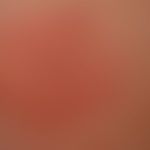DefinitionThis section has been translated automatically.
Circumscribed, variably sized, polyetiologic (exogenously or endogenously triggered) solitary, sharply or indistinctly circumscribed, pale to deep red or bluish-livid, normothermic or hyperthermic or, more rarely, hypothermic, red spot that is always anemic.
An erythema differs in color, size, arrangement and presents as a contrast to the non-reddened, bright surroundings. It is only through this contrast that an erythema can be perceived as such. In a dark or in black skin, depending on the pigmentation type, an erythema is only faintly recognizable, as a darkened spot or not at all. This complicates the morphological diagnosis immensely.
A universal redness of the entire integument is called erythroderma.
Furthermore, when evaluating an erythema, various clinical aspects must be considered and diagnostically evaluated. These are in particular:
- Size: in international literature, erythema is defined in terms of size as <1.0cm. An erythema > 1.0cm is called a patch (patches).
- Dynamics (static, acutely transient, acutely persistent, chronically persistent, crescendo reaction with increasing dynamics, wave dynamics with increasingPhase, plateau phase and decrescendo phase).
- Arrangement and shape (gyrate, herpetiform, serpiginous, in Blaschko lines (in vascular hamartomas of the skin), segmental, anular reticular, random due to external triggers, e.g., in dermatitis solaris)
- Border (sharp-edged, fuzzy, scalloped, jagged, random)
- Color (dull red, bright red, deep red, blue-red-v.a. in vascular hamartomas)
- temperature (hypo-, normo-, hyperthermic)
- Consistency (as a spot - unchanged from the surrounding skin; a "palpable erythema" would mark the transition to a papule with incipient, inflammatory infiltration)
- Symptomatology (mild itching, severe itching, burning itching, pain)
- Association with metabolic diseases, pregnancy, malignant tumors, autoimmune diseases.
- Exogenous triggering: physical (cold, heat, pressure, UV rays), biochemical (exertion, water, irritants), allergic (contact allergens), bacterial or mycotic infections.
- Endogenous triggering: bacterial, viral, mycotic infections, UAW (drug reactions), food allergies.
- Association with fever and/or other general symptoms (arthralgias, intestinal symptoms, lassitude) in the setting of macular exanthema.
A distinction must be made between solitary erythema and erythema as a partial symptom of a generalized or exanthematous disease (e.g., macular drug exanthem or classic infectious macular exanthem). In English, this flaring up of an erythema is called a "flare up." This distinction can be made by visual diagnosis in most cases. It is of great importance for the further examination procedure (exclusively regional examination or whole-body examination).
Another important aspect that can be assessed by visual diagnosis is the heliotropy of an erythema, the dynamics of an erythema (acute or persistent) and the assessment of the general condition of macular exanthema.
ClinicThis section has been translated automatically.
- Erythema (large spots, homogeneous), solitary: erysipelas; erysipeloid; tinea corporis; acute dermatitis, allergic; dermatitis solaris; actinic dermatitis; dermatomyositis, fixed toxic drug exanthema; erythema dyschromicum perstans; erythema chronicum migrans; acrodermatitis chronica atrophicans; lichen planus atrophicans; nevus flammeus; large parapsoriasis en plaques; ulerythema ophryogenes; rosacea; lupus erythematosus; erythrasma; pellagra; pellagroid; erythema diffusum hepaticum; erythromelalgia; Erythrosis interfollicularis colli; Pityriasis rubra pilaris; Erythema e pudore; Flush phenomena Erythema e calore; Erythroplasia; Erysipelas carcinomatosum;
- erythema (small spots, macular), multiple (exanthematic): pityriasis versicolor; erythema in (infectious) morbilliform, rubeoliform, scarlatiniform exanthema; pityriasis rosea; erythema infectiosum; drug exanthema; erythema multiforme; erythema elevatum diutinum; persistent cholinergic erythema; erythema anulare rheumaticum; erythema anulare centrifugum; erythema gyratum repens; lichenoid actinic keratosis.
Note(s)This section has been translated automatically.
A "red spot" is a frequent constellation of symptoms, its diagnosis clinically possible by its compressibility. And yet, this seemingly "simple constellation" requires further diagnostic consideration and examination: It is the important clinical analysis whether a red spot is anemic (erythema) or not (hemorrhage). This analysis is basically necessary for differential diagnostic reasons, since a red anemizable spot, i.e., erythema, must be separated from a red non-anemizable spot, e.g., in purpura.
Underlying the non-anemizable red spot is cutaneous hemorrhage. The diagnosis of"purpura" requires a fundamentally different examination cascade than the diagnosis of"erythema".
Incoming links (57)
Abacavir; Acute radiodermatitis; Amprenavir; Anakinra; Ariboflavinosis; Ashy dermatosis; Atopic anal dermatitis; Bazex-dupré-reilhac syndrome; Burning feet syndrome; Candida balanitis; ... Show allOutgoing links (42)
Acrodermatitis chronica atrophicans; Adverse drug reactions of the skin; Ashy dermatosis; Dermatitis; Dermatomyositis (overview); Erysipelas; Erysipelas carcinomatosum; Erysipeloid; Erythema anulare centrifugum; Erythema anulare rheumaticum; ... Show allDisclaimer
Please ask your physician for a reliable diagnosis. This website is only meant as a reference.











